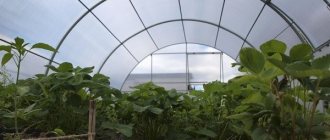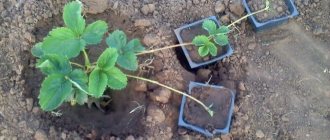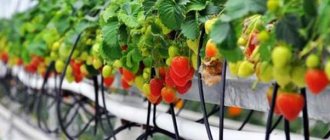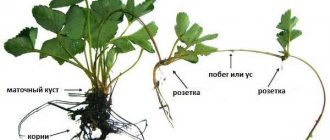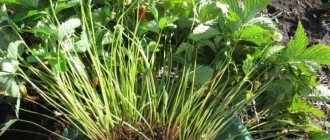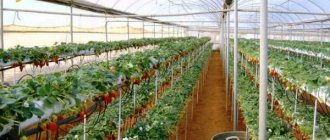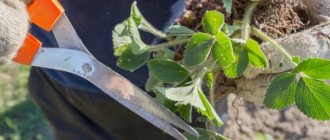Features of beds made of PVC pipes
To a gardener without experience, growing strawberries in pipes may seem like a strange solution. However, this method has been known for a long time. This design is easy to maintain, it is compact and can serve a decorative function.
The beds are made using PVC pipes, mostly sewer pipes. Straight parts can be easily combined into a larger structure using shaped elements. Using corners, crosses and tees, you can build a high pyramid from several pipes. They can be installed vertically and horizontally.
The resulting bed does not occupy a large area, so it can be placed even in a small area. It is important to clarify that not every variety of strawberry can be grown in PVC pipes.
Strawberries grown in a classic garden bed and those planted in PVC pipes require the same care. However, on dry days, the beds will have to be watered more often due to the small amount of soil. With the onset of winter, it is worth taking care of insulating the beds.
Essence and description of the method
This non-standard solution consists in erecting structures using various pipes (mostly PVC), which are placed both horizontally and vertically. All kinds of structures are built from this material, as far as the creator’s imagination allows. The pipes are filled with soil mixture or the cultivation is carried out hydroponically (aqueous nutrient compositions). Briefly, the essence of the method is as follows:
- Take pipes with a diameter of at least 15 cm from any suitable material. It can be not only plastic, but also aluminum or chrome steel.
- They are either cut in half (only in case of horizontal placement) or holes are made in them (about 8 cm in diameter) at a distance of 20–23 cm for planting.
- The placement of the holes depends on the planting method (horizontal or vertical). In the first case, the holes are made on one side, and in the second, they can be placed in a spiral, in a checkerboard pattern, or in some other way.
- Watering is most often carried out using a thin tube in which small holes are drilled to provide water flow.
- A thin watering tube is placed in the main pipe, which is filled with soil, and strawberry bushes are planted in it.
The hydroponics method is slightly different from cultivation in a soil substrate:
- is a pipe or other container filled not with a soil mixture, but with a nutrient solution;
- cups with plants are placed in this liquid;
- for greater stability, the cups are filled with expanded clay;
- To circulate water through the system, an aquarium pump is used, which delivers liquid to all bushes, washing their root system, after which it returns to the main container.
One vertically located two-meter pipe replaces a planting area measuring 4x6 m.
Did you know? Those who remember school botany well know that strawberries
-
this is not a real, but a false berry (multi-nut).
is
actually an overgrown receptacle with small brown seeds on the surface.
Advantages
The advantages of this method include:
- Allows rational use of free space on the site.
- The structure is light weight, due to which it can be placed in any place.
- When picked, the berries remain clean.
- No need to worry about weeding.
- It is convenient to water and feed the crop.
- Strawberries are protected from pests and diseases.
- Originality and well-groomed appearance.
Strawberries in a tube are beautiful, impressive, original.
Advantages and disadvantages
Growing strawberries using Dutch technology
Advantages of growing strawberries in horizontal PVC pipes:
- The soil or expanded clay is always moist in the pots, provided with nutrients, strawberries do not need to be dug up.
- To get more yield, it is worth trimming the growing tendrils.
- Weeds don't grow.
- Reduce the space for distribution - arrange the pipes vertically in a ladder in the form of a stepped pyramid;
- Use the mobility of the structure - do not be tied to one place and, if necessary, simply change the place of cultivation;
- At any time of the year, have fresh berries and, if you wish, create your own business;
- Reduce efforts to care for strawberries;
- Always have perfect berries - they don't touch anything.
Disadvantages of growing strawberries in horizontal PVC pipes:
- labor and money expenses for the construction of the structure;
- providing winter heating.
Flaws
However, this method also has some disadvantages:
- Strawberries in tubes should be watered regularly (at least once every 3-5 days).
- The soil in PVC beds requires regular feeding.
- Strawberries planted using this method are not frost-resistant and may die in winter. In such a situation, the vertical structure is laid in a horizontal position and covered.
Strawberry care
Plants are planted as usual: without deepening the root collar or exposing it too much. In vertical beds, small holes are made in the cells with your fingers, and the roots of the seedlings are placed in them. Strawberries are planted in horizontal beds in the classic way.
In the future, successful cultivation of strawberries depends on timely watering and fertilizing. It is worth remembering here that in plastic pipes the volume of soil is less than in ordinary soil. Therefore, watering needs to be done more often, especially in dry and windy weather.
Approximately once a week, watering is combined with fertilizing, adding to the water (1 g per 4 liters of water) a mixture of equal amounts of manganese sulfate, cobalt nitrate and boric acid with zinc. In order not to bother yourself with the selection of nutrients, this mixture can be replaced with a complex fertilizer for garden strawberries.
If the plantings are attacked by pests, use classic insecticides:
- from strawberry mites, weevils and whiteflies - “Karbofos”;
- from slugs and snails - “Metaldehyde”.
How to make a horizontal bed: step-by-step instructions
In order to understand what a structure is, you need to understand its features and find out how it is assembled.
How to make a horizontal bed for strawberries in PVC pipes, recommendations for the device:
- You need to decide where the garden bed will be located. For horizontal beds, a flat surface is ideal.
- Next, determine how many ribbons the structure will have (there may be several). It is better to locate them from north to south - this will reduce the likelihood of possible drought.
- The permissible gap between rows of strawberries grown horizontally in PVC pipes should not be less than 70 cm.
- The distance between seedlings should be 15-25 cm (this largely depends on the crop variety).
- To prevent strawberries from growing in the row, it is important to periodically remove the shoots.
- If a two-line planting is chosen, then the gap between the rows should be about 90 cm, and between neighboring strawberry bushes - 30 cm.
- If the location for the horizontal bed is chosen in a lowland where water stagnates, you will need to organize an additional embankment. Their height should be at least 30 cm, and their width should be from 60 cm to 100 cm. In this case, it is better to choose a two-line planting with an interval of 25-30 cm.
- The row spacing should be at least 30-40 cm, this will make caring for strawberries much easier.
When preparing horizontal pipes, the following should be taken into account:
- Plugs or plugs are placed at the ends of the pipe; instead of standard ones (if they are not available), homemade ones made from polyethylene film are also suitable.
- Planting holes for seedlings are not made over the entire area of the pipe, but in one or two lines.
- A regular pump is also suitable for watering, but the most common method is gravity watering. The container with water is attached above the watering pipe; it must be connected to the main structure.
About the benefits
Planting strawberries in vertical pipes has more advantages than the horizontal planting method. The main advantage is saving space. Plastic beds can be installed along the fence or on the sunny side of the house. Picking berries is much more convenient; you no longer have to stand with your back bent while harvesting.
The design is mobile, it can be freely moved from one place to another. Such an installation will become not only a fertile replacement for an ordinary garden bed, but also a decoration for a summer cottage.
How to write articles for a website correctly
- Fertilizing strawberries
Planting strawberries in the fall: tips and recommendations on when and how to plant strawberries correctly. Scheme of planting in open ground and caring for seedlings (115 photos)
Columns with berries can be installed in any order, and the combination of green and red colors will please the eye.
How to make a vertical bed
This type of bed made of plastic pipe would be appropriate for a small summer cottage. When there is very little free space, this design allows you to rationally use the space intended for growing strawberries.
Features of vertical design:
- The shape of the beds can be absolutely any, but most often you can find multi-tiered structures of a square shape.
- The height of the tiers should be 10-15 cm, and the width should be 20-30 cm. The gardener can select these parameters individually, since much depends on what variety of strawberries will be planted.
- Strawberries grown vertically in PVC pipes are more susceptible to the negative effects of weather. It is advisable to install arcs on the structure; if shelter is needed, polyethylene film is stretched over them.
The structure is easy to build if you follow the recommendations:
- Markings are made on the PVC pipe, along which it is then cut. Most often they choose a size from one to two meters. A plug is needed at the bottom of the pipe.
- A pipe of smaller diameter for irrigation is left 10 cm longer.
- Small holes are drilled in the inner pipe; they should be located opposite the larger diameter holes.
- A narrow pipe is wrapped with non-woven material, after which it is fixed around the entire perimeter.
- In the wide pipe you also need to make holes in a checkerboard or other order, leaving 20 cm at the bottom.
- A narrow pipe is inserted into a larger diameter pipe. The space is filled with expanded clay and covered with soil.
How to make a garden bed from plastic pipes
The assembly of vertical as well as horizontal ridges practically follows the same principle. The main body uses thick PVC pipe. Windows are cut out in the walls for planting strawberries. This is easier to do with an electric drill with a special cutting attachment - a crown. Further assembly steps will be slightly different, depending on the type of bed made of plastic pipes for strawberries that are supposed to be assembled.
How to make a vertical bed from a pipe
Before you start assembling the bed, you need to decide what the overall structure will look like. Pipes can be installed individually, strictly vertically, connected with shaped elements in the form of the letter V or another shape. When the final look is determined, they begin to make a vertical bed for strawberries from PVC pipes in the following order:
- For one segment of the bed, a PVC pipe with a thickness of 100-150 mm is prepared. The length is maximum 2 m. You will also need a piece of thin pipe with a diameter of 20 mm. Its length is 10 cm longer than the blank for the main body. A margin of length is necessary so that the thin pipe protrudes slightly for ease of pouring water.
- Holes are drilled in a large-diameter PVC pipe using a crown. The optimal diameter of the window is 7 cm. The first hole is drilled so that after installing the pipe it is located 20 cm higher from the ground level. The windows of the upper rows are cut at a similar distance, only in a checkerboard pattern. Planting nests are arranged in a checkerboard pattern
- A thin pipe is prepared according to a different principle. The walls are randomly perforated with a drill with a diameter of 8-10 mm. Instead of a thin PVC tube, you can use a watering hose. A watering hose is suitable instead of a thin PVC tube, but it is inconvenient to work with due to its flexibility
- Both pipes are closed on one side with a plug. These ends will be located on the underside of the bed. Plugs are used to seal both pipes from below.
- The main body of the bed is installed vertically in a permanent place. If the pipe is not part of the structure, but simply stands separately, it is secured from below. The easiest way is to put it in a bucket or other container and fill it with soil up to the first planting nest. A thin perforated tube is installed inside the main body. The area with holes is wrapped with nylon fabric or geotextile so that soil does not get inside through the perforations. A perforated irrigation tube is wrapped in nylon fabric or geotextile and installed inside the main body of the bed.
- Loading a thick pipe begins with drainage. Small stones and sand are poured onto the bottom. The next step is loading the soil. Fill it in layers. Having reached each hole at the height, the soil is compacted. The soil is backfilled in layers using a tamper.
When the bed is filled with soil, water is poured into the central tube to moisten it. Strawberry seedlings are planted in the windows.
When the strawberry bushes begin to develop, the pipe will disappear under dense foliage and berries
How to make a horizontal bed from a pipe
The principle of making a horizontal bed is similar, but there are some nuances. They are related to the organization of watering and the size of planting nests. The first step is to prepare the supports on which the beds will be laid. The choice of design depends on personal preference. You can build a rack or build a high embankment right on the ground. However, the second option is not considered the best solution. Growing strawberries will still be in contact with the main soil. There is practically no benefit from using the pipe.
Sometimes they make hanging beds from plastic pipes, fixing them on a fence, the facade of a building, or hanging them with ropes from powerful tree branches. When the support has been decided, we begin the main work:
- In a pipe with a diameter of 100-150 mm, windows are cut out in increments of 20 cm. The diameter of each planting nest is increased to 15 cm. It will be more convenient to plant strawberries, but the soil will still not spill out, since the pipe is laid horizontally.
- The resulting blanks are placed on a support. Further work depends on the selected irrigation technology. Most often, beds located horizontally in PVC pipes are equipped with a drip irrigation system with a surface laying of a hose. In this case, thick pipes are simply closed with plugs at both ends. Planting nests of horizontal beds increase in diameter to 15 cm
- Watering can be organized in another way. It is a bit reminiscent of the technology used for vertical beds. Take a flexible watering hose and perforate it at frequent intervals. To protect the holes from silting, it is wrapped with nylon fabric. The flexible hose is perforated in the area that will be located inside the bed
- A perforated hose is inserted inside a horizontally laid pipe. In this case, its plugs are replaced with shaped adapters with pipes with a diameter of 50 mm. One end of the hose is connected to the water supply, and the other is discharged into a drain or a prepared container, for example, a barrel or bucket. The irrigation hose is connected at one end to the water supply, and the other end is diverted into a drainage hole or bucket
- The bed body is loaded with soil through the planting nests. Strawberry seedlings are planted in each window. The bed is loaded with earth, strawberries are planted
To water such a bed, it is enough to supply water from the water supply to a perforated hose. Under pressure, it will drain through the free second end into the drainage well. However, some of the water will seep through the perforation and be absorbed by the soil.
Growing strawberries in PVC pipes
You can grow strawberries in pipes for different purposes, but it is important to know how to plant and care for the crop.
Varieties
Growing strawberries in tubes can be profitable if you choose the right varieties. It is recommended to choose:
- Yellow Miracle;
- Albion;
- Diamond;
- Homemade delicacy;
- Gigantella;
- Temptation.
The listed species are famous for their early ripening of berries, are resistant to pests, and will provide a one-year harvest. The ampelous varieties, which are classified as garden strawberries and have long mustaches, also take root well in plastic pipes.
The above-mentioned species allow you to harvest a large harvest; they can be distinguished by their appearance. The bushes resemble a cascade of foliage and shoots with a large number of berries and inflorescences.
Planting seedlings
After assembling the structure, it is time to plant the crop:
- small holes (about 10 cm) are made in pre-prepared soil;
- seedlings should be prepared in advance for planting (leaved for a day in the solution to stimulate root growth);
- the seedlings are planted in prepared holes, the roots should be evenly distributed and then sprinkled with soil;
- newly planted bushes need to be watered and left in a shaded place for the first week;
- it is necessary to adhere to the general planting schedule, since if you are late, the bushes may not take root in the new place.
Growing and care
Strawberries in PVC pipes also require proper care, which is as follows:
- moisten the soil in a timely manner as it dries out;
- as soon as the first berries appear, mulching will be required (it is better to take dry sawdust to eliminate the possibility of rot), you can repeat the steps in the middle or end of October;
- for preventive purposes, it is recommended to treat the bushes, this will avoid the appearance of pests (Karbofos is a good product for this);
- Regardless of which method of growing strawberries is chosen, the crop requires sufficient sunlight, and this also helps prevent the appearance of centipedes, snails, slugs and other pests.
Advantages and disadvantages
Recently, growing strawberries in a pipe has become very popular. If at the beginning of the use of this method it seemed more of an eccentricity, today it is appreciated by many gardeners (especially owners of small vegetable gardens or garden areas).
However, like any other technique, planting strawberries in pipes has its advantages and disadvantages. Among the obvious advantages are:
- Growing strawberries in PVC pipes allows you to significantly save space in your garden;
- in the manufacture of structures, you can use unnecessary pipe trimmings that remain after repairs or other household work;
- when growing strawberries in a limited space, the possibility of rooting secondary unnecessary rosettes is eliminated (if necessary, they can be easily removed);
- the mobility of the beds increases - if necessary, they can be moved to any other place without any problems;
- the likelihood of weed proliferation is reduced;
- strawberry roots are isolated from the ground, which will reduce the risk of developing diseases and attacks by harmful insects;
- eliminates the need to perform mandatory weeding (but the soil should still be loosened periodically);
- the berries do not come into contact with the soil and remain clean;
- the beds can be raised high above the ground and poultry or other animals can be safely let out to roam without fear that they will eat or crush the plants;
- Growing strawberries or wild strawberries in plastic pipes is an excellent decoration: beautiful columns with bright green leaves and red berries will be a wonderful decoration for any area.
However, before planting strawberries in a pipe, you should familiarize yourself with the negative aspects of this method:
- when growing a plant outside the ground, its survival rate at low temperatures decreases: the soil will quickly freeze, which can destroy the crop;
- the soil in mobile beds dries out faster than in an open area, so it is important to ensure regular soil moisture or connect a controlled continuous irrigation system;
- The construction of plastic structures themselves requires the investment of time and financial resources.
Preparing pipes for winter
By winter, the beds must be insulated, otherwise the strawberry roots will simply freeze. The mobile structure can be brought into the barn. If year-round harvesting is planned, then the beds are sent to a greenhouse.
If the structure cannot be moved, it is insulated outside. To cover horizontal pipes, use spruce branches or straw, and vertical pipes are insulated with clothing or agrofibre, and covered with waterproof material on top.
Strawberry varieties for growing
In pipes you can grow varieties of different fruiting periods:
- of the early ripening ones, Garnet or Krasavitsa Zagorye are good;
- with an average harvest time: Zenit, Nadezhda or Kulon;
- late cultures: Cinderella or Zenga-Zengana;
- Varieties of foreign selection are also good in such plantings, for example, Cardinal, Bogota, Troubadour or Gigantella;
- among early crops with a long fruiting period, remontant varieties are well suited: Diamant, Albion, Temptation or Moscow Delicacy;
- The ideal option is considered to be ampelous plants that grow long mustaches and bear fruit almost the entire season; among the best are the varieties Tuscany or Home Delicacy, as well as the hybrids Fresco and Home Charm;
- For hydroponic cultivation, only year-round remontant strawberries are used; professionals recommend Yellow Miracle, Elvira or Queen Elizabeth.
Did you know? Scientists have unraveled the genetic code of representatives of the Strawberry genus. As scientists from the University of Florida found, these plants have 35,000 genes (in humans
—
only 25000).
Tips for gardeners
In order for the result of the work done to be positive, you need to adapt to the non-standard technology for growing strawberries. Advice from experienced gardeners will help you avoid mistakes:
- suitable temperature for strawberry development is 18-23 degrees;
- the chosen place for the beds should be well lit, and the humidity level should be at least 70%;
- watering the soil depends on its condition;
- water the bushes at the roots; water should not get on the foliage;
- vertical beds, provided they are properly organized, can even be placed on balconies;
- An excellent solution would be to install the structure near the fence.
Initially, it may seem that the design of PVC pipes is quite complex. However, those gardeners who have become familiar with this technology can no longer imagine any other way of growing strawberries. If the berry is grown for sale, then a more ideal option simply cannot be found.
Suitable varieties
Remontant varieties are considered optimal for growing in pipe systems, but ordinary varieties can also be used, although the yield will be lower. The only exceptions are hybrids, which are not suitable for this technology, especially when using hydroponics.
It is best to grow early ripening species, which are easier to take root than others and are least demanding of care. These include:
- Albion;
- Pomegranate;
- Desnyanka;
- Diamond;
- Yellow miracle;
- Temptation;
- Beauty of Zagorje;
- Moscow delicacy;
- Baby elephant;
- Troubadour.
Related article:
Fertilizing strawberries with yeast
Strawberries Victoria in plastic pipes can only be grown horizontally. This is due to the fact that it forms a large, semi-spreading crown and produces a lot of fruits, the weight of which flower stalks in vertical plantings may not be able to withstand.
An excellent choice would be ampelous varieties of remontant varieties, on the young rosettes of which berries appear even without rooting. In addition to large yields, such strawberries have pronounced decorative properties and can become an original decoration for the site.
Preparation of planting material
To get an excellent strawberry harvest, you need high-quality planting material. When choosing seedlings, the following criteria should be taken into account:
- Seedlings must be covered by the root system, i.e. seedlings must be purchased in glasses.
- The roots of good seedlings are lobes more than five centimeters long.
- Seedlings can have no more than three leaves.
- The shoots should not show signs of disease.
If you do not plan to plant seedlings immediately after purchase, you need to prepare planting material:
- Prepare a solution of Plaabbermouth. Its composition contains, in a 1:1 ratio: Clay or soil, peat or humus. It is necessary to add water to them so that the solution looks like thick sour cream in consistency.
- Trim off excess leaves, leaving only two or three giants.
- Immerse the roots of the seedlings in the solution, which protects them from drying out and increases the likelihood of them taking root.
- Place polyethylene in the box in which the seedlings are placed.
- Store prepared seedlings at a temperature of 6-7 degrees Celsius.
To prevent the plant from dying, seedlings should not be planted too deep into the soil. Deepen the soil 14-16 cm so that the center point of the bush is slightly above the ground. With this planting, the seedlings have proven themselves well and will grow.
When the seedlings are planted in a hole, the hill should be turned into a mound and the strawberries should be placed on it so that the roots fall onto the hill. Planting holes are formed at a distance of 25-30 cm from each other.
After planting, the plant must be watered and covered with 5-6 cm of compost or 10 cm of sawdust. Then a greenhouse effect is created for the seedlings for better rooting; for this they are covered with a covering material.
In order for the seedlings to take root well and form flower buds, they need appropriate care:
- Watering. In the absence of rain, watering the riverbeds should be carried out 1-2 times a week.
- Mulching. To maintain soil moisture, the layers are lined with a mulch layer, such as straw or agro-fiber material.
- I'm eating. Seedlings are treated with a solution of urea (30 grams) and water (10 liters). Supplemental root food is prepared using molybdenum (2 grams), manganese (50 grams), boric acid (15 grams) and water (15 liters).
To achieve an excellent strawberry harvest next year, you need to prepare the land properly and buy quality seedlings. It is also important not to miss the best time to plant strawberries - August. And then ripe, tasty berries on the table will delight your family.
Page 3
If we talk about strawberries, there is always a red berry with a specific sweet taste and notes of delicate acidity.
If we remember strawberries, we will have a more pronounced taste and aroma.
And if we combine these two species, we get Zemklunik. In other words, a berry that combines the positive qualities of one type of berry and another.
How and where to place strawberry pipes
Such beds can be placed vertically or horizontally.
Advantages of vertical arrangement:
- saving space (several dozen bushes are placed per 1 m2);
- saving water, fertilizers and pest control products;
- ensuring maximum illumination for all berry bushes;
- ease of harvesting;
- originality of the appearance of facades, balconies, and adjacent areas.
Horizontal beds with planted strawberries are also an effective way to grow crops and decorate a site. They can be hung in a greenhouse, on a fence, or installed in an isolated area, placing the pipes in several tiers.
Hanging or ground-mounted racks can be used as support for horizontal beds. Vertically located strawberry beds serve as an original decoration for the site.
Basic mistakes
Below are the most typical mistakes that many summer residents and gardeners make when planting and growing strawberries in pipes.
Timely familiarization with them will prevent the risk of their recurrence in the future:
- Water regime violations. As already mentioned, the soil in the pipes is prone to drying out, but it should not be over-moistened, as this quickly leads to rotting of the root system and the death of the cultivated bushes.
- Failure to comply with watering rules. This procedure must be carried out extremely carefully; water should not get on the leaves, trunks, tendrils, berries or inflorescences.
- Failure to comply with planting deadlines. It is necessary to draw up a schedule and correctly calculate your time so that it is enough for both the installation of the structure and the timely planting of seedlings. Any delays may lead to the fact that strawberries simply do not have time to adapt to a new place and will face the winter in an unprepared state, which can lead to their death.
- Treatment of bushes containing berries with various insecticides or other means. All such procedures should be carried out only strictly after harvesting the ripe crop.
Planting strawberry seedlings in pipes
Strawberry seedlings can be planted while the pipes are being filled with soil or at the end, when the structure is fully assembled, secured and watered. For planting, healthy strawberry seedlings are selected, the roots of which are recommended to be dipped in a mash of equal parts clay and manure. This treatment will help the plant retain moisture better. A vertical depression is made in the soil, where the roots are placed, making sure that they do not bend. The root collar of the seedling is placed at ground level.
On a note! Between strawberry seedlings (if planted vertically, at the bottom of the structure), it is recommended to plant marigolds, which can repel harmful insects.
Seedlings cannot be planted in every planting hole. This arrangement will make it possible to root the emerging young shoots, renew and rejuvenate strawberry plantings.
Pest Control
The main pests that are dangerous to strawberries are aphids, slugs, ants, and mites.
To eliminate ticks, the use of karbofos is allowed. Snails and slugs are destroyed by using metaldehyde. Aphids are eliminated by spraying with tincture of onion, garlic or soap solution.
If an invasion of the Colorado potato beetle , it will have to be collected manually, since drugs that contribute to the death of the insect are harmful to the crop and can cause the death of the entire crop. To prevent the appearance of insects, the best solution is green manure - plants that repel pests.
How is care carried out?
Proper growing of strawberries in pipes vertically involves timely feeding and spraying of plants against pests. You also need to install the correct watering system; using a drip installation, the liquid is evenly distributed to each plant (to its root).
Watering should be done as the soil dries out, simply by testing it with your finger. Growing such strawberries is not difficult, you just need to arm yourself with useful knowledge and desire.
- As the soil dries, it must be moistened in a timely manner.
- When the first berries appear, it is necessary to mulch; for these purposes, it is best to use dry sawdust, which minimizes the risk of rot. This procedure will need to be repeated again in the middle or end of October; it will be part of a set of measures aimed at preparing the crop for the approaching winter.
- It is recommended to carry out a preventive treatment at least once to prevent the possibility of parasites. Karbofos is best suited for this: the solution is prepared by dissolving three tablespoons of the product in 10 liters of water.
- Do not forget that regardless of the growing method, strawberries still need to receive certain amounts of natural light and solar heat. In addition, this prevents the appearance of slugs, snails, centipedes or other types of pests. If they still managed to start, then you can use metaldehyde to destroy them.
Strawberries growing horizontally in PVC pipes are not susceptible to attack by pests living in the ground and weeds; the soil in the pipes does not need to be loosened. However, it is susceptible to disease, and the soil in the pipes, due to its small volume, loses moisture and nutrients faster. Therefore, when growing strawberries horizontally, care will differ from caring for strawberries in open ground. Features of care:
- maintaining constant soil moisture; automated drip irrigation may be ideal here;
- feeding strawberries twice a month;
- thorough removal of diseased bushes along with the soil underneath them;
In the absence of a heated greenhouse, overwintering strawberries in PVC pipes is a big difficulty. In our climate, such pipes will freeze, so they must either be well insulated or stored in the basement for the winter.
To insulate the structure, you need spunbond, which is used to wrap each pipe in two to three layers from the time the first frost begins. When the frost gets stronger, you need to wrap it again, but not individually, but the whole complex.
According to reviews from amateurs, growing strawberries horizontally in PVC pipes has found its supporters. They even make adjustments, namely: the gardener suggests filling the pipes with peat instead of soil. It holds water better, and before putting it in winter storage and after stopping watering, pipes with peat will weigh less and are easier to carry.
Another amateur suggested putting the pipes in trenches before winter and insulating them with straw. This is a great solution if you don't have a basement. Some advise simply lowering the pipes from the supports to the ground and insulating them with any available means. In places where the snow cover remains stable throughout the winter, this method is especially suitable.
The need for frequent watering is cited as a disadvantage, but when installing a drip irrigation system, this is not a problem. In any case, it is easier to water compact beds than to drag hoses around the entire area.
strawberries on the balcony
One of the basic rules for growing in this way is maintaining an optimal level of soil moisture.
With insufficient irrigation in summer, the soil inside dries out very quickly. If plants are overwatered, they can become seriously ill, which can lead to complete loss of the crop. If you use drip irrigation, the soil will become excessively moist in the lower part, while the upper plants will experience a lack of moisture.
The best option with this arrangement is to supply liquid at significant pressure, but for a short period of time.
Moreover, such watering, especially in the hot season, should be carried out at short intervals.
Making a structure from pipes for strawberries
You can make a vertical or horizontal structure yourself without much expense or effort.
To make a structure from PVC pipes, you need to prepare the necessary tools and materials. In a narrow pipe that will serve as a watering pipe, you need to drill frequent small holes.
To make beds from PVC pipes you will need:
- Two pipes: wide and narrow. There is no need to purchase them specially; you can use those left over after the renovation.
- Plugs, plugs.
- A device for drilling holes of various diameters.
- Parts for fastening.
- Twine or twine.
- A piece of non-woven material.
- Knife.
- Adhesive tape or tape.
In a larger diameter pipe you need to drill holes for planting strawberries.
The watering pipe must be wrapped in burlap, spunbond and the material securely fastened along its entire length.
Advantages of vertical planting of strawberries
The advantages include the following:
- economical use of planting space - with proper placement of structures (in layers, tiers, vertically), the yield from 1 m² of area can be equal to the amount of crop grown on 1 acre of an ordinary bed;
- mobility - if desired, such a bed can be easily and quickly moved to another place or storage room;
- no need for soil cultivation: removing weeds, loosening, mulching;
- always clean and healthy berries, since they practically do not come into contact with the ground;
- the possibility of decorating the landscape space of the site - unusual beds with hanging fragrant berries can become a decoration of the garden, a hedge.
- Geneva. An excellent American variety, tasty and very productive. With proper care it can produce 3 kg of berries.
- Alba. An Italian variety that appeared in Russia relatively recently. It has spindle-shaped bright red berries, tasty and juicy. An interesting feature of this particular variety is the same size of berries throughout the season; they do not become smaller even at the last harvest.
You should not take the soil on which tomatoes or potatoes were grown, otherwise the strawberries may become infected with some fungi or diseases. It’s better to add a small dose of mullein. To create a good drainage system, coarse gravel, crushed stone or other similar material should be poured 8-9 cm into the lower part of the pipes. Pour the soil mixture onto the drainage and compact it lightly. The soil in the pipe must be filled to the brim.
- plugs on the outer pipe are installed on both sides,
- holes for planting strawberries are drilled along the entire length, but only on one side, which will be located at the top,
- a small hole is made at the very center of the pipe to remove excess liquid, which is closed with a stopper if necessary,
- the lower part of the pipe is filled with expanded clay, and fertile soil is poured on top.
The feeding rates for strawberries look like this:
- Phosphorus 50 kg/ha. It should be applied before planting;
- Nitrogen 90 kg/ha. Half must be applied immediately before planting, the second part during the growing season. You also need to take into account the weather factor, that is, if some of the nitrogen fertilizers are washed away by precipitation, additional fertilizing will be needed;
- Potassium 100 kg/ha. Half should be applied before planting, the other half during the flowering period;
- Magnesium 100 kg/ha. Apply before preparing the soil.
You should also carry out foliar feeding with microelements, since it helps to increase the yield from 5 to 15%. The mixture should be applied during flowering (0.025%) and fruiting (0.05) of the berries.
The mixture must contain the following microelements:
- boric acid;
- cobalt nitrate;
- zinc sulfate and manganese.
Source
Many summer residents have questions related to the subsequent planting of strawberries in the created pipe structures. All the basic rules associated with this procedure are discussed below:
- Young seedlings are selected; a prerequisite is the presence of a developed root system with shoots of at least 10 cm.
- The planting material is pre-prepared, which consists of keeping it in a cool place with a sufficiently high level of humidity.
- It is important to adhere to the general schedule for planting strawberries, since missed deadlines can lead to the bushes not having time to take root in a new place and adapt to the conditions in which they find themselves.
- When planting, it is necessary to monitor the position of the root collar; it must be located at the same level with the surface of the soil and not go deep into it.
- The root shoots are placed inside the existing holes; they must be in a vertical position without any bends.
- Properly organized vertical structures can be placed not only on summer cottages, but also on balconies and loggias of city apartments.
- Using boards on the structure, you can organize numerous additional tiers. If the weather is warm outside, you can place containers with seedlings on them, which will later be transplanted into pipes.
- The structures can be placed along fences and further decorated; then they will become an excellent addition to garden design.
The use of vertical structures made of PVC pipes to grow strawberries is a practical option, the task of which is the rational use of land space. To arrange vertical flower beds or beds, you can use various PVC structures, which are sold at specialized points of sale.
Or you can make such a structure vertically with your own hands. An innovation in growing berries or vegetables is planting them in PVC pipes; they are intended for installing a sewer system.
The main materials for installing the system are:
- PVC pipes of large circumference, divided into sections;
- Drill with different drill bits;
- Plugs for PVC pipes;
- A PVC pipe of small circumference, it will be used for the flow of liquid to the root systems;
- Material for winding (usual burlap is often used);
- Fixing tight ropes;
- Substrate for growing plants;
- Any material for installing a drainage system;
- Bushes;
- Elements for fastening PVC pipes.
Experienced gardeners recommend growing plants in the lower part of the structure, in wide pipes, that help repel pests, insects, and larvae from strawberries. These can be flowers such as calendula or marigolds. Growing such flowers will repel various insects, preventing them from parasitizing on plants.
Vertical cultivation of strawberry bushes in pipes indicates the careful placement of plantings, sometimes in a position that is not very convenient for them. Gardeners recommend first filling the voids with soil, then simply making a hole in the ground with your finger and planting bushes.
In addition, with horizontal strawberries, in an ordinary garden plot, plant diseases are more likely to occur (since when strawberries are placed horizontally on the plot, fungal spores and viruses can spread even in deep layers of soil, and they need to be grown vertically using a sterilized substrate).
There is an experience of gardeners who filled a vertical pipe with soil 1/3 of diluted plant waste mixed with effective microorganisms. In the greenhouse, irrigation water and warm air from the surrounding area contributed to the rapid decomposition of waste and the release of large amounts of organic nutrients. The process is accompanied by the release of heat. This means you can save on heating the greenhouse.
Comparison of horizontal and vertical technologies:
- Vertical technology is more compact and produces more berries per 1 m2 compared to horizontal technology, but is more labor-intensive, since planting the upper bushes and harvesting from them is more difficult than from bushes located at the same level.
- The assembly of both installations is the same.
- Both installations have equally high pumping costs unless gravity feed is used.
Horizontal and vertical technology for growing strawberries in PVC pipes is considered intensive. The yield of bushes during the year is great. With the maximum level of nutrition and lighting in the greenhouse, you can get up to 4 strawberry harvests per year. After this, a complete replacement of the bushes is necessary. If you only get 2 or 3 harvests, then the bushes can be left for two years and then completely replaced.
The advantages of vertically planting strawberries in plastic pipes will be useful for every gardener who plans to use such technology.
Vertical planting and further cultivation of strawberries has the following advantages:
- Possibility to save useful area of the site. Compared to the traditional method, it is possible to plant more bushes in a smaller area. Accordingly, it is possible to achieve a high yield despite the fact that the main area of the garden can be used for other purposes.
- Mobility. The structures can be easily transported to any other necessary location. Moreover, this can be done even if the plants have already been planted.
- The plants grow correctly and do not shade each other, which often happens when the strawberries grow in the wrong place using the traditional planting method.
- Plants do not need loosening the soil or weeding. They grow well even without this, delighting with a significant harvest.
- The harvest is always clean and easy to harvest due to its lack of contact with the ground. This allows you to speed up the process of picking berries.
In principle, vertical strawberry beds are one of the ways to decorate a site. You can additionally take care of the decor of PVC pipes to make them look interesting.
- Mobility. PVC pipes with strawberries can be placed on the site where it is more convenient, as well as in a greenhouse or on a balcony. In addition, it is permissible to transport garden crops in pipes not only in the spring during planting, but also at any other time, if necessary.
- Minimum time spent on plant care, including initial soil preparation. The latter does not subsequently require loosening or weed control, which cannot but please gardeners.
- Ensuring the growth of garden crops without the intervention of a gardener. Planted strawberries or strawberries in a pipe grow on their own; they only require timely watering and picking the berries.
- Increase in harvest quantity. This happens due to the fact that a significant area is used for planting strawberry bushes directly in the pipe, and not in the garden.
- Convenient berry picking. This is explained by the fact that the berries are always clean, since there is no contact with the ground. As a result, the berries do not lose their presentation and always remain intact and beautiful.
A common feature of the methods is the use of strawberry plastic pipes. This equipment is used for growing plants, it is standard and does not have any special differences from ordinary PVC structures.
It is worth noting that not all varieties are suitable for growing in pipes. It is best to choose early species. They take root as quickly as possible and do not require serious and painstaking care.
Planting strawberries in PVC pipes
